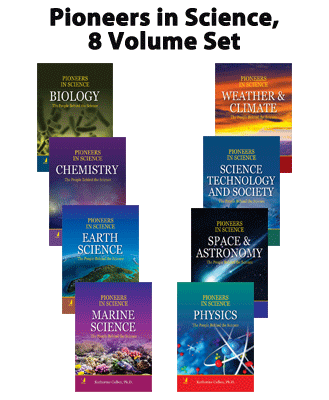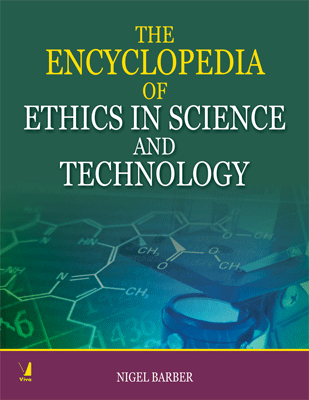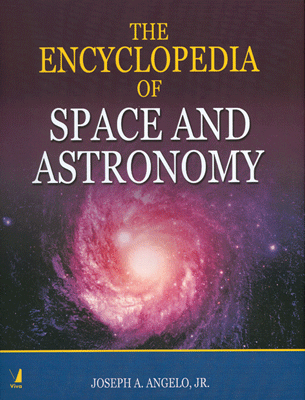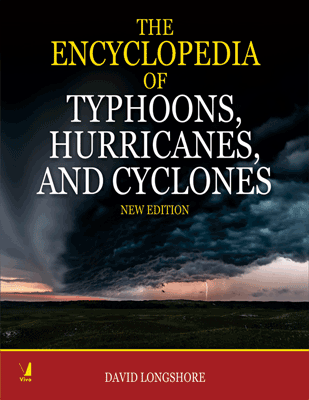Pioneers in Science, 8 Volume Set
Pioneers in Science, 8 Volume Set
The People Behind the Science
₹8,095.50 ₹8,995.00 Save: ₹899.50 (10%)
Go to cartISBN: 9788130933818
Bind: Hardbound
Year: 2017
Pages: 1536
Size: 185 x 241 mm
Publisher: Facts On File Inc.
Published in India by: Viva Books
Exclusive Distributors: Viva Books
Sales Territory: India, Nepal, Pakistan, Bangladesh, Sri Lanka
Pioneers in Science is essential set for students, teachers and general readers who require information about maverick scientists.
VOLUMES IN THE SET INCLUDE
Biology
Description:
Biology: The People Behind the Science contains 10 biographical portraits of individuals who contributed significantly to the development of modern biology. Each chapter contains relevant information on the scientist's research, discoveries, and lasting contributions to the field and concludes with a chronology and a list of print and Internet references specific to that individual.
The scientists covered are:
William Harvey (1578-1657)
Thomas Hunt Morgan (1866-1945)
Antonivan Leeuwenhoek (1632-1723)
Charles Henry Turner (1867-1923)
Carl Linnaeus (1707-1778)
Sir Alexander Fleming (1881-1955)
Charles Darwin (1809-1882)
Rita Levi-Montalcini (1909-)
Gregor Mendel (1822-1884)
James D. Watson (1928-)
Biology contains more than 30 evocative black-and-white photographs and line illustrations, a glossary, a helpful list of print and Internet resources, and an index.
Contents:
Preface • Acknowledgments • Introduction
CHAPTER I: William Harvey (1578-1657): On the Circulation of Blood throughout the Body
From Folkestone Farmboy to London Physician • Galen's Authority Questioned • Blood Circulation • Malpighi's Discovey of Capillaries • Reproduction and Embryology • Father of Modern Physiology • Chronology • Further Reading
CHAPTER 2: Antoni van Leeuwenhoek (1632-1723): Discovery of Microscopic Life
Son of a Basket Maker • A Skilled Lens Grinder • Animalcules • Prokaryotes and Eukaryotes • Pepper and Fame • Microorganisms on Humans • Precious Scopes Bequeathed • Chronology • Further Reading
CHAPTER 3: Carl Linnaeus (1707-1778): Binomial Nomenclature System
Little Botanist • The University Years • Plant Sexuality • Lapland and Europe • Organization of Life • Physician and Teacher • Binomial Nomenclature System • Father of Taxonomy • Modem Taxonomy • Chronology • Further Reading
CHAPTER 4: Charles Darwin (1809-1882): Natural Selection as a Mechanism for Evolution
Divergence from Planned Career • Purpose in a Trip around the World • Formulation of a Groundbreaking Theory • Delay in Publishing New Theory • Success and Controversy • Alfied Russel Wallace • Chronology • Further Reading
CHAPTER 5: Gregor Mendel (1822-1884): The Father of Genetics
Son of a Peasant Farmer • Disappointment and Failure • Revelation of the Secrets of Heredity • Too Good to Be Tme? • Meteorology and Bees • Thirty-Five Years Later • Chronology • Further Reading
CHAPTER 6: Thomas Hunt Morgan (1866-1945): The Roles of Genes and Chromosomes in Heredity
A Famous Family • Sea Spiders and Frog Eggs • The Dawn of Genetics • Sex Determination Mechanims • In the Eye of a Fly • Gene Mapping • First Geneticist to Receive a Nobel Prize • Chronology • Further Reading
CHAPTER 7: Charles Henry Turner (1867-1923): Insect Behavior
A Janitor's Son • Homing in Ants • Bee Behavior • Tricky Trappers • Learning in Cockroaches and Moths • Animal Behavior Pioneers • A Dedicated Researcher • Chronology • Further Reading
CHAPTER 8: Sir Alexander Fleming (1881-1955): The Miracle Drug
A Late Start in Medicine • Research on Infections and Inoculations • Magical Substance in Mucus and Tears • Growing Bacteria • The Wonder Drug • Progress at Oxford • Widespread Fame • Chronology • Further Reading
CHAPTER 9: Rita Levi-Montalcini (1909-): The Discovery of Nerve Growth Factor
Desire for a Professional Career • Clandestine Investigations • A Signal for Neuron Growth • Tumors, Snake Venom, and Salivary Glands • Nerve Growth Factor Action and Promise • Home Again • Chronology • Further Reading
CHAPTER 10: James D. Watson (1928-): The Double Helical Structure of DNA
A Typical Midwestern Beginning • The Puzzle Pieces • The Ruthless Race • Rosalind Franklin (1920-1958) • The Finish Line and Beyond • Positions of Influence • Chronology • Further Reading
Glossary • Further Resources • Index
Chemistry
Description:
Chemistry: The People Behind the Science contains 10 biographical portraits of individuals who contributed significantly to the development of chemistry. Each chapter contains relevant information on the scientist's research, discoveries, and lasting contributions to the field and concludes with a chronology and a list of print and Internet references specific to that individual.
The scientists covered are:
Joseph Priestley (1733-1804)
Antoine Lavoisier (1743-1794)
John Dalton (1766-1844)
Dmitry Mendeleyev (1834-1907)
Irving Langmuir (1881-1957)
Email Hermann Fischer (1852-1919)
Gerty Cori (1896-1957)
Percy Julian (1899-1975)
Linus Pauling (1901-1994)
Dorothy Crowfoot Hodgkin (1910-1994)
Chemistry contains more than 30 evocative black-and-white photographs and line illustrations, a glossary, a helpful list of print and Internet resources, and an index.
Contents:
Preface • Acknowledgments • Introduction
CHAPTER I: Joseph Priestley (1733-1804): The Discovery of Oxygen
Strict Calvinist Upbringing • A Popular Teacher • The Invention of Carbonated Beverages • Different Kinds of Air • The Discovery of Oxygen • A Challenge to Phlogiston Theory • Studies on Photosynthesis • How Plants Make Food • Controversial Works • Immigration to America • Chronology • Further Reading
CHAPTER 2: Antoine Lavoisier (1743-1794): The Basis and Language of Modem Chemistry
A Family of Lawyers • The Ferme G??n??rate • From Water into Dirt? • The Oxygen Theory of Combustion • Claude-Louis Berthollet (1748-1822) • The Language of Chemistry Rewritten • Research on Respiration • The Execution of Lavoisier • Chronology • Further Reading
CHAPTER 3: John Dalton (1766-1844): The Chemical Atomic Theory
A Quaker Upbringing • A Natural Philosopher • The Manchester Literary and Philosophical Society • Daltonism and Atmospheric Sciences • The Tiniest Parts • A New System • Baron F??ns Jakob Bmelius (1779-1848) • Numerous Awards for a Humble Quaker • Chronology • Further Reading
CHAPTER 4: Dmitry Mendeleyev (1834-1907): The Periodic Table of the Elements
Tragic Beginnings • Structure-Function Relationships of Chemical Substances • Finally, a Unifying Principle • The Periodic Table of the Elements • An Ambitious Activist • An Element in His Honor • Chronology • Further Reading
CHAPTER 5: Irving Langmuir (1881-1957): Advancement of Surface Chemistry
Early Promise • Freedom to Pursue His Research • Refinement of the Atomic Structure Model • Advancements in Surface Chemistry and the Nobel Prize • Katharine Burr Blodgett (1898-1979) • Controlling the Weather • Chronology • Further Reading
CHAPTER 6: Emil Hermann Fischer (1852-1919): Synthesis of Purines and Sugars and the Mechanism of Enzyme Action
A Choice of Science • Kekul?? and Benzene • A Chemist on the Move • An Early Discovery • What Caffeine and Barbituates Have in Common • Differences in Sugars • Amino Acids and Proteins • Lock and Key • The Death of a Remarkable Organic Chemist • Chronology • Further Reading
CHAPTER 7: Gerty Cori (1896-1957): Sugar Metabolism and Glycogen Storage Disorders
A Life Partnership • Carl Ferdinand Cori (1896-1984) • Hormonal Control of Carbohydrate Metabolism • Chemistry in a Test Tube • First American Female Nobel Prize Recipient • Glycogen Storage Diseases • Death of a Hero • Chronology • Further Reading
CHAPTER 8: Percy Julian (1899-1975): Synthesis of Glaucoma Drug and Sterols from Natural Plant Products
Catching Up • Aspirations for More • Soybean Chemist Extraordinaire • Steroidal Syntheses • Chemical Messengers • A Humane Scientist • Chronology • Further Reading
CHAPTER 9: Linus Pauling (1901-1994): Description of the Nature of the Chemical Bond
Boy Professor • Pauling's Rules and Chemical Bonding Theory • Hybridization in the Special Case of Carbon • The Structure and Function of Biological Molecules • Protein Conformations • A Molecular Disease • Antibomb Activism • Belief in a Miracle Vitamin • Chronology • Further Reading
CHAPTER 10: Dorothy Crowfoot Hodgkin (1910-1994): X-Ray Analysis of Biologically Important Molecules
A Sketchy but Worldly Education • Fascination with Crystals • Primitive Lab, Superior Results • The Structure of Penicillin • Too Complex for Chemical Analysis • Realization of the Potential • Honored Mother of Crystallography • Medically Signifiant Choices • Chronology • Further Reading
Glossary • Further Resources • Periodic Table of the Elements • The Chemical Elements • Index
Earth Science
Description:
Earth Science: The People Behind the Science contains 10 biographical portraits of individuals who contributed significantly to the development of earth science. Each chapter contains relevant information on the scientist's research, discoveries, and lasting contributions to the field and concludes with a chronology and a list of print and Internet references specific to that individual.
The scientists covered are:
Georgius Agricola (1494-1555)
William Smith (1769-1839)
Nicolaus Steno (1638-1686)
Sir Charles Lyell(1797-1875)
James Hutton (1726-1797)
Alfred Wegener (1880-1930)
Alexandervon Humboldt (1769-1859)
Arthur Holmes (1890-1965)
Georges Cuvier (1769-1832)
Stephen Jay Gould (1941-2002)
Earth Science contains more than 30 evocative black-and-white photographs and line illustrations, a glossary, a helpful list of print and Internet resources, and an index.
Contents:
Preface • Acknowledgments • Introduction
CHAPTER I: Georgius Agricola (1494-1555): The Forefather of Geology and the Father of ine era logy
?Peasant Farmer? • An Expert on Mining • Mining and Metallurgy • A Prolific Author • On Metallurgy • Chronology • Further Reading
CHAPTER 2: Nicolaus Steno (1638-1686): The Law of Superposition of Rock Layers and the Principles of Original Horizontality and Lateral Extension
An Interest in Science • The Seashell Question • Discovery of a Salivary Duct • Questioning Descartes • Cartesian Philosophy • Studies on Muscular Contraction • Glossopetrae • A Forerunner • Devotion to Catholic Missions • Chronology • Further Reading
CHAPTER 3: James Hutton (1726-1797): Uniformitarianism as the Central Principle of Historical Geology
A Lawyer's Apprentice • Geological and Agricultural Studies • ?Theory of the Earth? • The Effect of Natural Processes on the Shape of the Earth • Opposition • Support for Hutton's Theory • Chronology • Further Reading
CHAPTER 4: Alexander von Humboldt (1769-1859): Unification of the Natural Sciences
A Career in Politics or Mining • An Exotic Expedition • Volcanoes • Highest Altitude • The Larger Task • That Lay Ahead • Diamonds in the Urals • Geomagnetism • Cosmic Comprehension • Chronology • Further Reading
CHAPTER 5: Georges Cuvier (1769-1832): The Reality of Extinction of Past Life-forms
Birth in Montb??liard • A Man with Many Titles • Identification of Animals from Fossil Remains • Fossils and Paleontology • Extinction and Catastrophism • Still an Anatomist • Cuvier's Legacy • Chronology • Further Reading
CHAPTER 6: William Smith (1769-1839): Creation of the World's First Geological Map
Pound Stones • Career as a Surveyor • The Birth of Stratigraphy • Mary Anning • The World's First Geological Map • Respected at Last • Chronology • Further Reading
CHAPTER 7: Sir Charles Lyell (1797-1875): The Gradual Nature of Earth's Processes
Preference of Geology over Law • Uniformity Revealed • William Buckland • Principles and Elements • Expertise Abroad • The Age of Man • Knighthood and Baronetcy • Chronology • Further Reading
CHAPTER 8: Alfred Wegener (1880-1930): The Theory of Continental Drift
From Astronomy to Meteorology • A Land-Moving Theory • A Revolution from International Controversy • Plate Tectonics • A Bitter Cold Ending • Chronology • Further Reading
CHAPTER 9: Arthur Holmes (1890-1965): Estimation of the Earth's Age
The 20-Million-Year Dispute • Entrance to the Dating Game • Mozambique • Carbon Dating • The Problem with Lead • Misfortune and Providence • The Powerful Engine of Radioactivity • A Fourth Isotope • Primeval Lead Composition • The End of Time for a Famous Geologist • Chronology • Further Reading
CHAPTER 10: Stephen Jay Gould (1941-2002): Theory of Punctuated Equilibrium
A Young Boy's Interest in Paleontology • Evolution by Jerks • Darwin's View • A Prolific and Influential Writer • A New Structure for Evolutionary Theory • Reflections and Miscellany • Chronology • Further Reading
Glossary • Further Resources • Index
Marine Science
Description:
Marine Science: The People Behind the Science contains 10 biographical portraits of individuals who contributed significantly to the development of marine science. Each chapter contains relevant information on the scientist's research, discoveries, and lasting contributions to the field and concludes with a chronology and a list of print and Internet references specific to that individual.
The scientists covered are:
Sir C. Wyvllle Thomson (1830-1882)
Fridtjof Nansen (1861-1930)
William Beebe (1877-1962)
Henry Bigelow (1879-1967)
Ernest Everett Just (1883-1941)
Harry Hammond Hess (1906-1969)
Jacques-Yves Cousteau (1910-1997)
Eugenie Clark (1 922-)
Sylvia Earle (1935-)
Robert Ballard (1942-)
Marine Science contains more than 30 evocative black-and-white photographs and line illustrations, a glossary, a helpful list of print and Internet resources, and an index.
Contents:
Preface • Acknowledgments • Introduction
CHAPTER I: Sir C. Wyville Thomson (1830-1882): Director of the First Purely Scientific Oceanographic Expedition
A Series of Academic Posts • Life in the Azoic Zone • The Famous Challenger Expedition • Mid-Atlantic Ridge • The Challenger Reports • Chronology • Further Reading
CHAPTER 2: Fridtjof Nansen (1861-1930):O ceanographer and Polar Explorer
An Outdoor Childhood • A Viking Voyage • Studies on the Invertebrate Nervous System • Carnillo Golgi • Across the Ice Cap • Forward! • Farthest North • Oceanographer Recipient of Nobel Peace Prize • Chronology • Further Reading
CHAPTER 3: William Beebe (1877-1962): Exploration of Deep-Sea Life
Early Interest in Wildlife • Wilderness Adventures • Tropical Research • The Arcturus Expedition • Haiti and Bermuda • The Bathysphere Dives • The Bathyscaph • Inspiration to Others • Chronology • Further Reading
CHAPTER 4: Henry Bigelow (1879-1967): The Complex Ecology of the Sea
From Birds to the Sea • The Gulf of Maine • Alexander Agassiz • Complex Ecology of the Sea • WHO I and Harvard • Chronology • Further Reading
CHAPTER 5: Ernest Everett Just (1883-1941): Marine Invertebrate Embryologist
Opportunity in Education • Doctoral Research on Sandworms • Frank Rattray Lillie • A Growing Reputation • Sand Dollar Fertilization • Escape from Racism • Magnum Opus • Chronology • Further Reading
CHAPTER 6: Harry Hammond Hess (1906-1969): Model of Seaf loor Spreading
The Little Admiral • From the Atlantic to the Pacific • Baffling Marine Geology Discoveries • Proposal of Seafloor Spreading • Admired and Honored • Robwt Sinclair Dietz • Chronology • Further Reading
CHAPTER 7: Jacques-Yves Cousteau (1910-1997): The Invention of the Aqualung and Popularization of Marine Biology
A Childhood on the Move • Career-Changing Accident • Invention of the Aqualung • Undersea Research Group • Diving Dangers • The Calypso • The Conshelf Experiments • Legacy of Conservation • Chronology • Further Reading
CHAPTER 8: Eugenie Clark (1922-): Expert on Poisonous Fish and Shark Behavior
An Early Fascination with Fish • Respected Ichthyologist • A Lab of Her Own • Shark Behavior • Sharks • New York and Maryland • Shark Repellent and Sleeping Sharks • Outreach • Chronology • Further Reading
CHAPTER 9: Sylvia Earle (1935-): Pioneer of Scuba Use for Marine Research
From a Farm to the Coast • Algal Expert • Algae • Underwater Habitat • Swimming with Humpbacks • Record-Breaking Dives • A Mission to Preserve • Chronology • Further Reading
CHAPTER 10: Robert D. Ballard (1942-): Discovety of Black Smokers and Advancement of Deep-sea Exploration Techniques
California Boyhood • Thwarted Career Plans • Geological Evidence for Plate Tectonics • The Center of Creation • In Search of Hot Water • Black Smokers • The RMS Titanic • The Unsinkable Ship • Shifting Interests • Numerous Contributions to a Variety of Fields • Chronology • Further Reading
Glossary • Further Resources • Index
Physics
Description:
Physics: The People Behind the Science contains 10 biographical portraits of individuals who contributed significantly to the development of physics. Each chapter contains relevant information on the scientist's research, discoveries, and lasting contributions to the field and concludes with a chronology and a list of print and Internet references specific to that individual.
The scientists covered are:
Sir Isaac Newton (1642-1727)
Albert Einstein (1879-1955)
Michael Faraday (1791-1867)
Niels Bohr (1885-1962)
Max Planck (1858-1947)
Louis de Broglie (1892-1987)
Ernest Rutherford (1871-1937)
Richard Feynman (1918-1988)
Lise Meitner (1878-1968)
Murray Gell-Mann (1929-)
Physics contains more than 30 evocative black-and-white photographs and line illustrations, a glossary, a helpful list of print and Internet resources, and an index.
Contents
Preface • Acknowledgments • Introduction
CHAPTER I: Sir Isaac Newton (1642-1727): The Law of Universal Gravitation and Three Laws of Motion
No Telltale Signs of Genius • Cambridge University • The Miracle Year • Robert Hooke • A Hidden Proof • Magnificent Principia • Life Outside of Academics • Death of Sir Isaac • Chronology • Further Reading
CHAPTER 2: Michael Faraday (1791-1867): Discovery of Electromagnetic Induction
Humble Beginnings • Assistant to Davy • Davy ?s Intoxicating Discovery • Construction of the First Electric Motor • Growing Reputation • Electromagnetic Research • Electrochemistry and Light • Plain Michael Faraday • Chronology • Further Reading
CHAPTER 3: Max Planck (1858-1947): The Concept of Quanta of Energy
Thermodynamics • The Ultraviolet Catastrophe • The Quantum Concept • The Most Coveted Award • Personal Tragedies • An Honored Physicist • Chronology • Further Reading
CHAPTER 4: Ernest Rutherford (1871-1937): Discovery of the Atomic Nucleus
Son of a Flax Farmer • A Stimulating Atmosphere • Pioneers in Radioactivity • A Productive Partnership • Frederick Soddy • Description of the Atom • A Deliberate Change • Chronology • Further Reading
CHAPTER 5: Lise Meitner (1878-1968): Nuclear Fission • The Struggle to Obtain an Education • Boltzmann ?s Imprint • A Basement in Berlin • The Mother Substance and Transuranics • The Impossible Conjecture • Fallout • Due Recognition • Chronology • Further Reading
CHAPTER 6: Albert Einstein (1879-1955): The Theory of Relativity
A Slow Start • The Dual Nature of Light • Brownian Motion • Everything Is Relative • The Experiment That Failed • More Generally • Grand Unification Failure • Chronology • Further Reading
CHAPTER 7: Niels Bohr (1885-1962): A Quantum Mechanical Model of the Atom
An Impressive Scientific Pedigree • Explanation of an Atomic Conundrum • Quantum Superstars • Correspondence and Complementarity • Looking
Inward • Bohr's Legacy • Chronology • Further Reading
CHAPTER 8: Louis de Broglie (1892-1987): The Foundation of Wave Mechanics An Aristocratic Family • The Problem • What Is a Wave? • Revolutionary Thesis • Proof and Debate • Founder of a New Field • Chronology • Further Reading
CHAPTER 9: Richard Feynman (1918-1988): Development of the Theory of Quantum Electrodynamics
Early Signs of Genius • Princeton and the War • Paul Dirac • The Most Perfect Theory of Physics • Arrows and Amplitudes • An Intellectually Stimulating Environment • A Public Legacy • Chronology • Further Reading
CHAPTER 10: Murray Cell-Mann (1929-): Classification of Elementary Particles and Their Interactions
Pet Genius • Classification of Elementary Particles • Meeting of the Minds • Eightfold Way • Proposal of Quarks • Quantum Chromodynamics • Striving Toward Unification • A Busy Retirement • Chronology • Further Reading
Glossary • Further Resources • Index
Science, Technology and Society
Description:
Science, Technology and Society: The People Behind the Science contains 10 biographical portraits of individuals who contributed significantly to the development of science, technology and society. Each chapter contains relevant information on the scientist's research, discoveries, and lasting contributions to the field and concludes with a chronology and a list of print and Internet references specific to that individual.
The scientists covered are:
Louis Pasteur (1822-1895)
Rachel Carson (1907-1964)
Marie Curie (1867-1934)
William Shockley (1910-1989)
Guglielmo Marconi (1874-1937)
Patrick C. Steptoe (1913-1988)
Sir Frederick Banting (1891-1941)
Kary Mullis (1944-)
J. Robert Oppenheimer (1904-1967)
Ian Wilmut (1944-)
Science, Technology and Society contains more than 30 evocative black-and-white photographs and line illustrations, a glossary, a helpful list of print and Internet.
Contents
Preface • Acknowledgments • Introduction
CHAPTER I: Louis Pasteur (1822-1895): Cocredited for the Germ Theory of Disease and Developed First Vaccines
A French Education • Studies on Crystals • Fermentation • Only Life Begets Life • Savior of the Wine and Silk Industries • Kocb ?s Postulates • The Germ Theory of Disease • Miracle Vaccines • Pasteur's Memory Honored • Chronology • Further Reading
CHAPTER 2: Marie Curie (1867-1934): Discovery of the Elements Radium and Polonium
Polish Heritage • The Sorbonne • Two New Elements • A Doctorate and a Nobel Prize • Tragedy and Scandal • War Efforts • The Nobel Prize in Chemistry 1935 • Death from Cancer • Chronology • Further Reading
CHAPTER 3: Cuglielmo Marconi (1874-1937): The First Transatlantic Radio Transmission
An Early Interest in Physics • Invention of the Wireless Telegraph • Electromagnetic Waves • Demonstration of the Utility of Wireless Telegraphy • Successful Transatlantic Transmission • The Father of Radio • Chronology • Further Reading
CHAPTER 4: Sir Frederick C. Banting (1891-1941): Discoverer of Insulin
Farm Boy Becomes Military Surgeon • Repairing Childhood Deformities • Hormone X • A Miracle Cure • Biotechnological Insulin Production • Mistaken Credit • Silicosis and Wartime Research • Chronology • Further Reading
CHAPTER 5: J. Robert Oppenheimer (1904-1967): Construction of the First Nuclear Weapon
Born with a Silver Spoon • Master of the New Physics • Theoretical Physics in the United States • The Controversial Manhattan Project • Enrico F m i • A Question of Loyalties • Chronology • Further Reading
CHAPTER 6: Rachel Carson (1907-1964): The Dangers of Pesticide Overuse
An Emerging Author • Studies of Life • Merger of Two Loves: Science and Writing • Greater Success • Threat of a Silent Spring • Negative Reaction-Positive Change • The Environmental Protection Agency • Pioneer of the Environmental and Ecological Movements • Chronology • Further Reading
CHAPTER 7: William Shockley (1910-1989): Inventor of the Transistor
Specialization in Solid-State Physics • The Old Technology • Semiconductors • The Team • The First Transistor • Controversy • Initiation of the Computer Revolution • Chronology • Further Reading
CHAPTER 8: Patrick C. Steptoe (1913-1988): Pioneer of In Vitro Fertilization
A Royal Navy Volunteer • Development of Laparoscopic Surgery • A Complementary Partnership • Initial Promising Results • Perseverance through Failures • Success! • Modern ART • Hope for Millions • Chronology • Further Reading
CHAPTER 9: Kary B. Mullis (1944-): Invention of the Polymerase Chain Reaction
An Explosive Introduction to Chemistry • A Winding Road to an Interesting Molecule • The Concentration Problem • Beauty in Simplicity • Gradual Acknowledgment • A Stable Enzyme • Positive and Negative Publicity • Chronology • Further Reading
CHAPTER 10: Ian Wilmut (1944-): The First Cloned Mammal
The Development of an Interest in Development • The Unplanned Path to Dolly • A Frenzied Response • Reproductive v. Therapeutic Cloning in Humans • After Dolly • Many Hopes • Chronology • Further Reading
Glossary • Further Resources • Index
Space & Astronomy
Description:
Space and Astronomy: The People Behind the Science contains 10 biographical portraits of individuals who contributed significantly to the development of space and astronomy. Each chapter contains relevant information on the scientist's research, discoveries, and lasting contributions to the field and concludes with a chronology and a list of print and Internet references specific to that individual.
The scientists covered are:
Nicholas Copernicus (1473-1543)
Tycho Brahe (1546-1601)
Galileo Galilei (1564-1642)
Johannes Kepler (1571-1630)
Benjamin Banneker (1731-1806)
Sir William Herschel (1 738-1822)
Robert H. Goddard (1822-1945)
Wernhervon Braun (1912-1977)
Carl Sagan (1934-1996)
Stephen Hawking (1942-)
Space and Astronomy contains more than 30 evocative black-and-white photographs and line illustrations, a glossary, a helpful list of print and Internet resources, and an index.
Contents
Preface • Acknowledgments • Introduction
CHAPTER I: Nicholas Copernicus (1473-1543): The Founder of Modern Astronomy
A Privileged Childhood • Inspired to Study Astronomy • Copernicus Recognizes a Need for Change • A Brief History Accepted Astronomy • Observations and Calculations Begin • The Heliocentric System Marks a Scientific Revolution • The Religious Scandal • Copernicus's Legacy • Chronology • Further Reading
CHAPTER 2: Tycho Brahe (1546-1601): The Astronomer Who Revolutionized Techniques of Celestial Observation
Born into Privilege • Lunar Eclipse Shifts His Educational Goal toward Astronomy 18 • A Need for Change in Observational Accuracy • Design Begins on Observational Instruments • Tycho Brahe's Metal Nose • Space and Astronomy • His Discoveries on the Supernova of 1572 • The First Observation of a Supernova • The Book De nove stella Gains Him Fame • Europe's First Astronomical Research Facility Is Built on • Hven Island • The Distant Comet and the Tychonic System • Brahe's Legacy • Chronology • Further Reading
CHAPTER 3: Galileo Galilei (1564-1642): Physicist Revolutionizes Astronomical Observation with the Newly invented Telescope
Born in Pisa • Medical Studies Are Discarded in Favor of Physics and Astronomy • Career as a Math Tutor Begins • Galileo ?s Famous Cannonball Experiment • Galileo Adopts Copernicanism • The New Star and the Telescope • Copernicanism Deserves Support • Consequences of Nonconfomity • The Inquisition • Galileo Is Condemned as a Heretic • Chronology • Further Reading
CHAPTER 4: Johannes Kepler (1571-1630): The Father of Celestial Mechanics
Born into Poverty • Scholarship Advancement • A Surprise Career in Mathematics and Astronomy • A Restless Mind • The Five Regular Solids • Kepler Attempts to Lend Proof to Copernicanism • He Assists a Master • The New Master Battles with Mars • The Formulation of Kepler's Laws • Kepler's War against Witchery • The Crowning Achievement • Kepler's Legacy • Chronology • Further Reading
CHAPTER 5: Benjamin Banneker (1731-1806): The First African-American Astronomer
Born into Freedom • The Necessities of Farm Life Induce Self-Education • His First Brush with Notoriety • Molly Welsh • An Influential Arrival • At Age 57, Banneker Tackles Astronomy • From Farmer to Astronomer • Brilliant Creation and Blinding Disappointment • The Importance of the Eighteenth-Cenmy Almanac • Fate Lends a Hand • An Unexpected Turn of Events • His First Almanac • The Last Years • Chronology • Further Reading
CHAPTER 6: Sir William Herschel (1738-1822): The father of sidereal Astronomy
In the Footsteps of His Father • An Escape to England • Caroline Herschel • Herschel Refines the Art of Optic-making • A Monumental Discovery • The King's Astronomer • Telescope Building at Home • The Shaping of the Galaxy • A Knight's Tale • Chronology • Further Reading
CHAPTER 7: Robert H. Goddard (1882-1945): The Father of Modern Rocketry and Space Flight
A Boy Surrounded by Creativity • The Cherry Tree Incident • The Wrong College • A New Path • Isaac Newton's Three Laws of Motion • A Man with a Secret Mission • The de Lava Nozzle • Rockets in Space • A Career in Rocketry • Goddard's Kitty Hawk • Bad Press Brings Good News • The Reach for New Heights • A Broken Spirit • Goddard's Legacy • Chronology • Further Reading
CHAPTER 8: Wernher von Braun (1912-1977): The Twentieth Century's Foremost Rocket Engineer
Aristocratic Heritage • A Man with a Singular Vision • The VFR • Opportunity Knocks • Joint Forces • The Wrong Planet • From Adversary to Ally • The Space Race • The Pressure Mounts • From Out of the Blue • The Pinnacle of Success • A Visionary to the End • Chronology • Further Reading
CHAPTER 9: Carl Sagan (1934-1996): Modern Popularizer of Space Science • and Cofounder of the New Field of Exobiology
Born in Brooklyn • How Will You Make a Living? • The American Dream • A New Field of Science • The Dark Bands of Mars • The Unforgiving Search for Extraterrestrial Life • Contact beyond the Solar System • The Champion of Space Science • Cosmos • Carl Sagan Is a Household Word • Sagan's Legacy • Chronology • Further Reading
CHAPTER 10: Stephen Hawking (1942-): The Modem Einstein
An Unusual Birthday • Talent and Scholarship • Tragedy, Heartbreak, and Depression • Turning Point • Singularity Theory and the Universe • General Theory of Relativity • The Big Bang Theory • Theory on Black Holes • Cosmology Stardom • A Brief History of Time • Scientific Icon • Calling for the Death of Physics • Chronology • Further Reading
Glossary • Further Resources • Index
Weather & Climate
Description:
Weather and Climate: The People Behind the Science contains 10 biographical portraits of individuals who contributed significantly to the development of weather and climate. Each chapter contains relevant information on the scientist's research, discoveries, and lasting contributions to the field and concludes with a chronology and a list of print and Internet references specific to that individual.
The scientists covered are:
Evangelista Torricelli (1608- 647)
Benjamin Franklin (1706-1790)
Luke Howard (1772-1864)
Sir Francis Beaufort (1774-1857)
Louis Agassiz (1807-1873)
William Ferrel(1817-1891)
John Tyndall (1820-1893)
Cleveland Abbe (1838-1916)
Vilhelm Bjerknes (1862-1951)
Paul J. Crutzen (1933-)
Weather and Climate contains more than 30 evocative black-and-white photographs and line illustrations, a glossary, a helpful list of print and Internet resources, and an index.
Contents
Preface • Acknowledgments • Introduction
CHAPTER I: Evangelista Torricelli (1608-1647): Inventor of the Mercury Barometer
Galileo's Assistant • The Invention of the Barometer • Contributions to Mathematics • How a Thermometer Works • A Premature Ending • Chronology • Further Reading
CHAPTER 2: Benjamin Franklin (1706-1790): Lightning As an Electrical Phenomenon
The Family Business • Printing Apprentice • On His Own • Poor Richard's Almanack • The Pennsylvania Fireplace • Experiments with Electricity • So What Actually Happened? • Studies on Whirlwinds and the Gulf Stream • A Founder of a New Nation • Chronology • Further Reading
CHAPTER 3: Luke Howard (1772-1864): Classification of Cloud Types
Watching the Sky • Science in His Spare Time • On the Modification of Clouds • Cloud Formation • Authority on Meteorology • Modern Cloud Classification • Chronology • Further Reading
CHAPTER 4: Sir Francis Beaufort (1774-1857): Establishment of a Scale for Wind Force
False Records • A Passion for Sea Life • The Need for Standard Weather Reporting • What Moves the Air and the Water? • A More Precise Scale • International Scale Adoption • Matthew Fontaine Maury • Beaufort's Legacy • Chronology • Further Reading
CHAPTER 5: Louis Agassiz (1807-1873): Proof for the Existence of a Great Ice Age
Assistant to Cuvier • Studies on Glaciers • Glaciers • Resistance • How the Motions ofthe Earth Affects Its Climate • A One-Way Trip to the United States • A Foundation for Paleoclimatology • Chronology • Further Reading
CHAPTER 6: William Ferrel (1817-1891): Effect of the Earth's Rotation on Atmospheric and Oceanic Circulation
Mathematics on a Barn Door • The Newton of Meteorology • Tides • The Effect of Rotation on Moving Bodies • Tide-Predicting Machine • Coriolis Effect • Chronology • Further Reading
CHAPTER 7: John Tyndall (1820-1893): The Effect of Invisible Gases on the Earth's Temperature
Surveyor, Lecturer, Fellow • Glacial Motion • Father of the Greenhouse Theory • Radiant Heat • Why the Sky Is Blue • Foghorns • The Defeat of Spontaneous Generation • Popularization of Natural Philosophy • Chronology • Further Reading
CHAPTER 8: Cleveland Abbe (1838-1916): America's First Weatherman
Dreams of Astronomy • From Russia to Washington • The Daily Weather Bulletin • Creation of a National Weather Service • A Matter of Time • Time Measurement • A Useful Servant • Chronology • Further Reading
CHAPTER 9: Vilhelm Bjerknes (1862-1951): The Movement of Air Masses in the Atmosphere
A Father's Influence • Physical Hydrodynamics • An Ambitious Program • Battle in the Atmosphere • Jacob Bjerknes • Father of Modem Meteorology • Chronology • Further Reading
CHAPTER 10: Paul J. Crutzen (1933-): Depletion of the Ozone Layer
Hardships • A Second Career • Mario J. Molina • SSTs and Anthropogenic Chlorine • Hole in the Ozone • Biomass Burning and Nuclear Winter • Honors and Impact • Chronology • Further Reading
Glossary • Further Resources • Index
About the Author:
Katherine Cullen, Ph.D., holds a doctorate in molecular biology from Vanderbilt University. A former college professor she has also taught science and trained teachers for Kaplan Educational Services. In 2002 she initiated and coordinated for undergraduate science majors a training program in biomedical research. Cullen acted as abridgement editor for four Schaum's Easy Outlines: Biology, Biochemistry, Molecular and Cell Biology, and Beginning Chemistry.







